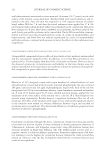J. Cosmet. Sci., 72, 189–199 (March/April 2021) 189 Improving Oxidative Stability of Cosmetic Emulsions with Plant Extracts: Current Status and Potential ANICA PETKOVIC, VLADIMIR JAKOVLJEVIC, MARINA TOMOVIC, JOVANA JEREMIC, GORDANA RISTIC, and JOVANA BRADIC , Department of Pharmacy, Faculty of Medical Sciences, University of Kragujevac, Kragujevac 34000, Serbia (A.P., M.T., J.J., J.B.), Department of Physiology, Faculty of Medical Sciences, University of Kragujevac, Kragujevac 34000, Serbia (V.J.), Department of Human Pathology, 1st Moscow State Medical University IM Sechenov, Moscow 119991, Russian Federation (V.J.), Department of Dermatovenerology, Faculty of Medical Sciences, University of Kragujevac, Kragujevac 34000, Serbia (G.R), Clinical Centre Kragujevac, Center for Dermatovenerology, Kragujevac 34000, Serbia (G.R) Accepted for publication December 15, 2020. Synopsis There are increasing demands for cosmetic emulsions with natural active components such as plant extracts because of their myriad benefi ts. Quality of cosmetic emulsions may be affected by distribution and storage processes, which can lead to peroxidation of lipid components. Lipid peroxidation results in undesirable alterations in effi cacy, texture, and appearance of the cosmetic product, thus indicating a need to fi nd a safe and potent compound to be added in products to postpone oxidation processes. In that sense, the current article gives an overview of parameters infl uencing oxidative stability of emulsions, as well as methods for assessing the oxidative stability. Emphasis is given to the usage of plant extracts rich in phenolics for improving oxidative stability of cosmetic emulsions. Application of plant extracts in cosmetic emulsion is promising because of their signifi cant antioxidant properties which may delay lipid peroxidation during storage. Plant species are a valuable source of biologically active compounds that might be exploited in the cosmetic and pharmaceutical industry. SKIN-CARE EMULSIONS Since the discovery in 1925, emulsions have been widely used in food, pharmaceutical, cos- metic industries, etc. (1). They represent the most common type of the delivery system in cosmetics, especially those formulated as creams and lotions (2). An emulsion is a complex mixture of two immiscible phases, with one phase dispersed in another (3). Their application as cosmetic products is frequently referring to as the O/W type, which contains typically 12–22% (w/w) oil (4). On the other hand, W/O emulsions are recommended for soothing and Address all correspondence to Jovana Bradic at jovanabradickg@gmail.com.
JOURNAL OF COSMETIC SCIENCE 190 softening the skin as well as in the treatment of dry skin (3,5). To stabilize emulsions, as ther- modynamically instable systems, different emulsifying agents are required in formulations (6). There are increasing demands for cosmetic products, thus requiring manufacturers to design novel high-quality formulation in a short period. Stability represents one of the essential fac- tors to be accomplished while developing a cosmetic emulsion. In that sense, identifi cation of the most suitable, adequate, and rapid methods for determining the product stability is of a great signifi cance (7). Much scientifi c attention has been dedicated to plant extracts as active components of cosmetic emulsions because of their myriad benefi ts (3). OXIDATIVE STABILITY OF COSMETIC EMULSIONS During distribution and storage processes, different alterations may occur in cosmetic emul- sions, thus altering the quality of the product. In fact, creaming, aggregation or fl occulation, coalescence, and oil–water separation have been considered as processes resulting in the lower- ing or loss of product effi ciency (8,9). Although the aforementioned processes lead to physical instability, there is also a great concern regarding oxidative instability of products as a result of oxidation of lipid components. Unsaturated fatty acids present in cosmetic oils are effi cient in skin hydration and strengthening however, their oxidation disturbs the properties of emul- sion (4). Numerous data support the fact that the O/W emulsion type is more susceptible to lipid oxidation because of the large interfacial area between the oil and water phases (10). It has been proposed that major reactions of lipid oxidation involve interaction between hydro- peroxides from the surface of the oil phase and transition metals from the aqueous phase (11). Certain factors such as light and/or high temperature might provoke lipid oxidation (2,12). Lipid oxidation is followed by the formation of harmful compounds which com- promise the safety and effi cacy of emulsion. The process of lipid oxidation in cosmetic emulsions is initiated through withdrawing hydrogen atoms from unsaturated fatty ac- ids, which leads to the generation of alkyl free radicals. Once a radical is formed, it reacts with other molecules, resulting in the formation of other radicals. This reaction occurs rapidly and continues until the radical is neutralized via reaction with other radicals (9). Therefore, certain compounds that are able to delay these processes are necessary in design and formulation of emulsions. Otherwise, lipid oxidation will result in undesirable al- terations in texture and appearance of cosmetic emulsions (11). FACTORS AFFECTING OXIDATIVE STABILITY OF EMULSIONS Scientifi c efforts have been invested in elucidation of factors that infl uence lipid oxidation in emulsions and the underlying mechanisms. It has been proposed that emulsifi cation methods and composition of the O/W emulsion strongly affect the oxidation processes in cosmetic products (13,14). Numerous factors have been listed as potential contributors to lipid oxidation such as fatty acid composition, pH value, type and concentration of anti- oxidants and pro-oxidants, emulsion droplet and interfacial properties, and lipid droplet characteristics (15). Available evidence suggests that a decrease in oil droplet size in- creases the possibility of oxidation. Possible explanations might lie in the increase in the specifi c surface area and higher oxygen consumption of small droplets (9). The presence of oxidative initiators such as iron, ribofl avin, or chlorophyll might accelerate the process of oxidation in the product (16,17).
Purchased for the exclusive use of nofirst nolast (unknown) From: SCC Media Library & Resource Center (library.scconline.org)

























































































































